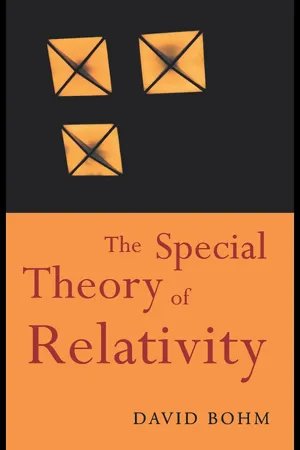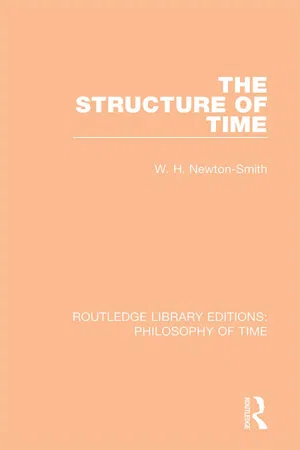Physics
Einstein's Theory of Special Relativity
Einstein's Theory of Special Relativity, proposed in 1905, revolutionized our understanding of space and time. It states that the laws of physics are the same for all non-accelerating observers and that the speed of light is constant for all observers. This theory led to groundbreaking concepts such as time dilation, length contraction, and the famous equation E=mc^2.
Written by Perlego with AI-assistance
7 Key excerpts on "Einstein's Theory of Special Relativity"
Learn about this page
Index pages curate the most relevant extracts from our library of academic textbooks. They’ve been created using an in-house natural language model (NLM), each adding context and meaning to key research topics.
- eBook - ePub
Electromagnetics Explained
A Handbook for Wireless/ RF, EMC, and High-Speed Electronics
- Ron Schmitt(Author)
- 2002(Publication Date)
- Newnes(Publisher)
* He also had the physics to back up his statement. It took decades, but Einstein’s theory of relativity gradually gained full acceptance of the scientific community after countless experiments proved him to be correct. At this point in the 21st century, I think it is safe to say that Einstein was correct and perhaps his theory should now be called the law of relativity. Close to 100 years of scrutiny and experimentation have passed without a single failure. Of course, general relativity isn’t the end of physics. Most notably, relativity and quantum physics have yet to be merged. There has been hope in recent years that string theory will provide the unified theory of physics, commonly called the Theory of Everything.I cannot in one chapter teach the entirety of relativity, but I can highlight the most important aspects of relativity and mention the relation of relativity to electromagnetics. The basic premise behind Einstein’s work is that we should be able to write the laws of physics such that any event or phenomenon can be described by the same laws, regardless of who does the measurement. In other words, there should be a universal set of laws to describe observations, regardless of whether the observer is stationary, moving at a constant speed, or accelerating. Moreover, there must be a set of equations to translate measurements from one reference frame to another. When Einstein first introduced his theory in 1905, he covered the topics of stationary and constant speed observers. This subset of relativity is called special relativity. Later, in 1916, Einstein introduced his theory of general relativity, which not only provided the framework for any type of motion, including acceleration, but also provided a new theory of gravity. Gravity is not like other forces. Gravity manifests itself as the curvature (warping) of space-time. Mass causes space-time to curve, and the curvature of space-time determines how other masses move.For the understanding of electromagnetics, special relativity is all that is really needed. The entirety of special relativity can be summarized in two simple statements: - eBook - ePub
Teaching Einsteinian Physics in Schools
An Essential Guide for Teachers in Training and Practice
- Magdalena Kersting, David Blair(Authors)
- 2021(Publication Date)
- Routledge(Publisher)
Herrmann and Job, 2019 ).Paradigm Change
Additional postulate of special theory of relativity
The laws of special theory of relativity, or special relativity for short, are derived from those of classical mechanics along with one extra postulate. Traditionally, and for historical reasons, the choice was made for the invariance of the speed of light upon a change of the reference frame.As one becomes aware that this choice, as a starting point, is only one of the several possibilities, one discovers that completely new perspectives arise for the development of a teaching concept. We have decided to introduce the mass–energy equivalence as an additional postulate instead of the invariance of the speed of light:Postulate of special relativity: mass–energy equivalenceWith this choice, one arrives more quickly at that part of special relativity that we consider being the most important one, namely relativistic dynamics.The traditional choice of the invariance of the speed of light has a rather incidental cause: when special relativity came into being, light was the only known system that behaved relativistically. Einstein's work – both his famous publication of 1905 (Einstein, 1905 ) and his textbook Grundzüge der Relativitätstheorie (Einstein, 1970 ) – begins with a detailed, and one can say somewhat tiring, part on relativistic kinematics.One might imagine what the course of history would have been if the first relativistic observation had been that a cup of hot coffee is heavier than a cup of cold coffee (or that the corresponding observation had been made with particles in an accelerator). The presentation of the theory of relativity in our textbooks would certainly be very different from what it is today.Of course, the mass–energy equivalence is not supported by our everyday experience (neither is the invariance of the speed of light). But one can make it easily plausible and discuss its consequences even in beginners' classes. It leads to surprising and, at first, unbelievable statements; but it does not lead to the cognitive conflicts one has to deal with in the traditional approach to relativistic kinematics which question our basic convictions about space and time. - eBook - ePub
- David Bohm(Author)
- 2015(Publication Date)
- Routledge(Publisher)
general theory of relativity, which is beyond the scope of the present discussion.)Einstein did not regard the above result as a deduction from the Lorentz theory, but as a basic hypothesis which was evidently subject to experimental tests and which had in fact already been confirmed in many experiments at the time Einstein first developed his theory (having since then been confirmed in a much wider variety of experimental contexts, and never yet having been refuted).To see more clearly what this hypothesis implied with regard to the meaning of the notions of simultaneity in physics, Einstein considered a simple experiment. It is only an imagined experiment in the sense that we do not, at least for the present, possess instruments sensitive enough to do what is called for. Yet this experiment is in principle possible; and it has the advantage that reflection on it brings out clearly the essential difficulty in older notions of what constitutes simultaneity of two separated events.Consider a train moving on a railway embankment with a velocity v. Let us suppose that there is an observer fixed on the embankment at the point O, more or less adjoining the middle of the train. This observer has two colleagues situated at A and B, possessing well-synchronized clocks in relation to the embankment, as shown in Figure 13–1 . A and B are assumed to be the same distance, l, from O, as measured by rulers at rest relative to the embankment. Suppose that O’s colleagues at A and B set off flashes of light, and that these flashes reach O at the same time. From the fact of their being seen together, it evidently does not necessarily follow that they originated at the same time. Indeed, O must correct, taking into account the time for light to reach him from A and from B. Since the distances are the same, and since the speed of light is the same in both directions, it follows that in this case O - eBook - ePub
- David Bohm(Author)
- 2003(Publication Date)
- Routledge(Publisher)
general theory of relativity, which is beyond the scope of the present discussion.)Einstein did not regard the above result as a deduction from the Lorentz theory, but as a basic hypothesis which was evidently subject to experimental tests and which had in fact already been confirmed in many experiments at the time Einstein first developed his theory (having since then been confirmed in a much wider variety of experimental contexts, and never yet having been refuted).To see more clearly what this hypothesis implied with regard to the meaning of the notions of simultaneity in physics, Einstein considered a simple experiment. It is only an imagined experiment in the sense that we do not, at least for the present, possess instruments sensitive enough to do what is called for. Yet this experiment is in principle possible; and it has the advantage that reflection on it brings out clearly the essential difficulty in older notions of what constitutes simultaneity of two separated events.Consider a train moving on a railway embankment with a velocity v. Let us suppose that there is an observer fixed on the embankment at the point O, more or less adjoining the middle of the train. This observer has two colleagues situated at A and B, possessing well-synchronized clocks in relation to the embankment, as shown in Figure 13–1 . A and B are assumed to be the same distance, l, from O, as measured by rulers at rest relative to the embankment. Suppose that O’s colleagues at A and B set off flashes of light, and that these flashes reach O at the same time. From the fact of their being seen together, it evidently does not necessarily follow that they originated at the same time. Indeed, O must correct, taking into account the time for light to reach him from A and from B. Since the distances are the same, and since the speed of light is the same in both directions, it follows that in this case O - eBook - ePub
- W. H. Newton-Smith(Author)
- 2018(Publication Date)
- Routledge(Publisher)
VIII THE SPECIAL THEORY OF RELATIVITY Does Oxford stop at this train? Apocryphally attributed to Einstein 1 THE SPECIAL THEORY OF RELATIVITY No mention has yet been made of the Special Theory of Relativity (hereafter cited as STR) and as this theory is popularly supposed to embody a radical challenge to our ordinary concepts of space and time (and to the Platonist conception) this lacuna must now be filled. We need to explore the implications, if any, of the theory for the general debates between the Platonist and the reductionist and to explore what implications it has, if any, for the theses advanced concerning the topology and metric of time. To begin with, an account of the theory will be offered. There would be little excuse for offering yet another account of the theory if it were not for the fact that the most philosophically perspicuous way of developing the theory is as yet generally unappreciated by philosophers. This is the derivation of the Lorentz transformations by Zeeman. 1 To begin with let us think in terms of our reconstruction of the notion of a timing system of using a clock to map events in the vicinity of that clock into some mathematical system in such a way as to generate a precise quantified representation of the dates and durations of these events. We will call such a date map a local date map. We are interested ultimately in assigning dates and durations to all events in the physical universe. To this end we can think of extending our local time map to cover all events. Such an extension will be called a global date map. If we assume a relation of simultaneity as an equivalence relation defined on the set of all events, we have a natural technique for extending any local time map. Any event is assigned the dates that would be assigned to an event simultaneous with it which occurs in the vicinity of the clock - eBook - ePub
- Barry Dainton(Author)
- 2016(Publication Date)
- Routledge(Publisher)
But this isn't quite the end of the story. Given the Relativity Postulate and the abandonment of absolute motion, Bob is perfectly entitled to regard himself as at rest and Alice to be moving at a speed of 150000 km s -1. From Bob's standpoint it is his readings that are correct and Alice's that are deviant, since when he observers Alice he will see that her measuring rod has contracted and her clock is running slow. Since (according to Einstein) both perspectives are equally valid, there is no objective fact of the matter as to who is right. And of course, there are many other perspectives on the same facts – those of potential observers in different inertial reference frames, all of whom are entitled to regard themselves as at rest, and all of whom will find Alice and Bob to have different states of motion relative to themselves. The distinctive innovation of STR is the replacement of one absolute for another. Newton's absolute space and time are both rejected, and a new absolute or invariant quantity is introduced; the velocity of light. Since velocity involves both distance and time, the only way for a given light ray to have the same velocity in frames of reference that are in motion relative to one another is for distances and times to vary in systematic ways in the relevant frames, and the Lorentz equations allow us to calculate the precise differences. Hence the recognition of the new invariant required the rejection of the old: according to Newton the distances and times between objects are both absolute quantities, and so invariant across frames of reference. Time dilation and length contraction initially strike us as utterly bizarre phenomena because they are not observed to occur in ordinary life. When travelling on a moving train, we can make the phone call we agreed to make at 2 p. m. without using the Lorentz equations to work out how much "train-time" differs from "land-time' ? - eBook - ePub
Fields of Force
The Development of a World View from Faraday to Einstein.
- William Berkson(Author)
- 2014(Publication Date)
- Routledge(Publisher)
26 More important even than these new results, though, was the change which Einstein had suggested in the picture of nature. How Einstein’s world picture differed from the earlier picture of Lorentz, I shall explain in the following section.THE NOVELTY OF THE THEORY: WHY RELATIVITY IS DIFFICULT TO UNDERSTAND
Relativity, including special relativity, has the reputation of being a theory which is both very novel and not very understandable. Why is this? The reason for the supposed difficulty of special relativity is not the mathematics; the Lorentz transformations are simple linear algebraic equations. And I think that the explanation does not lie in the bizarre results: length contraction, time variation or mass increase. These effects occurred in Lorentz’s theory of 1895, where they are explained as the results of self-induction and distortion of the field due to motion through the ether. But in Lorentz’s theory they do not seem to put us at sea, as in Einstein’s theory. The reason for the perplexing character of Einstein’s theory lies mainly in the peculiarity of the world view advocated by Einstein.The novelty of the special theory of relativity also did not lie particularly in its equations or its results. The transformations Einstein deduced were the same as those found independently by Lorentz. Two of the novel predictions which could be put to experiment were the second-order time effect and the related relativistic Doppler effect. These predictions are very interesting, but I think it is fair to say, do not in themselves constitute any revolution in physics. More crucial was Einstein’s recognition that a reverse Lorentz transformation, or the result of two Lorentz transformations, is also a Lorentz transformation. This means that the relative velocity of the ether is absolutely undetectable, which had not been realized by Lorentz. Poincaré, however, independently saw that the Lorentz transformation implied the undetectability of the ether. Indeed, I think Poincaré, Lorentz and Larmor are often not given the credit due them for their part in the creation of the theory of relativity,27 but it is none the less true that the theory as we know it bears the unmistakable imprint of the mind of Einstein. This is because for Einstein, unlike Lorentz and Poincaré, the relativistic transformations were to be interpreted by a new world view






